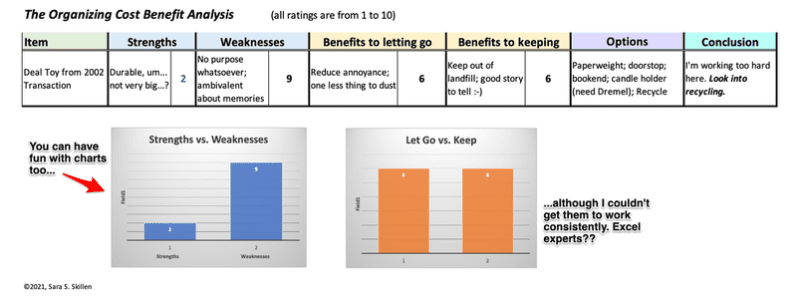Previously on The Stuff Behind The Stuff…
When we last left our heroine, she was mulling over an objective, systematic approach to decluttering decisions and reminiscing about her days in the legal/financial world. Well, maybe not exactly reminiscing, but certainly remembering a lot. We join her this week as she continues her quest to find the ultimate solution for her objet de curiosité – her “deal cube.”
–
Will she crack the code for objectively working through her choice? And if she does, will it make sense to anyone but her?? Let’s tune in (cue the harp)…
–
…OK, so for starters, you guys wouldn’t believe how much stuff there is on the Internet about deal cubes. I discovered they are more commonly known as deal toys or (and I like this one even better): financial tombstones. Many companies specialize in making these things. They’ve been around since the 1950s. There are Pinterest pages featuring people’s collections of vintage tombstones. And there’s a thread or two with plaintive appeals to the greater financial community about what the heck to do with them once you’ve left a company or bank—no helpful answers there (other than potential weaponry – we won’t go there).
–
You’ll remember, too, that I was pondering the whole Cost-Benefit Analysis thing. Could we warp and bend such a model to our need for other ways to think through a decision? A refresher on the Wikipedia definition provides clues:
–
Cost–benefit analysis (CBA)…is a systematic approach to estimating the strengths and weaknesses of alternatives used to determine options which provide the best approach to achieving benefits while preserving savings (for example, in transactions, activities, and functional business requirements). [bolding mine]
–
So, I put my rusty, dusty paralegal skills to use and played with Excel. Excel was a total revelation when I first learned how to use it – because you guys, it mathed for me! I’m no master-level user, but I still get around on it well enough to create something like this:
–
–
What do you think? I couldn’t get “preserving savings” to work as worded, but overall I think the chart captures the elements we’re looking for. Maybe a glorified “pros and cons,” but it gives it a slightly different container.
–
You could also use it for deciding how to commit your time:
–
–
If you wanted to give something like this OCBA (“ock-bah??”) a shot, you totally wouldn’t have to use Excel for it… you could hand-draw something, or make a table in Word, or use sticky notes on a whiteboard. Keep it simple – I spent maybe a touch too much time playing with this, but if it seems helpful, I might refine it and roll out a fill-in-blank version to use with clients.
–
As you can see in the first chart, I still came up a little bit blank on the deal toy – no incredible resolution or fresh idea. Sometimes letting go of stuff is not revolutionary. But after all, I managed to squeeze two blog posts out of this thing. In my research, I came across this company that will recycle the lucite, and of course, I have the picture (it’s been worth more than a thousand words). My tombstone has served its un-useful purpose in ways I would never have dreamed of back in 2002.
–
And so, our story comes to a close for this week. Be sure to let me know your thoughts in the comments.





